Materials Found on the Monju Scroll
Materials Found on the Monju Scroll
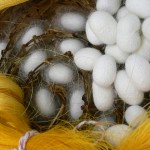
Silk – The Monju scroll is painted on silk and then mounted on silk fabric. Silk is a natural fiber which is produced by certain insect larvae to form cocoons like the ones seen in the picture above. The shimmering appearance of silk is due to the triangular prism-like structure, which allows silk cloth to refract incoming light at different angles.
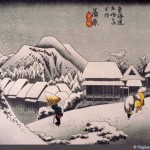
Ink – Ink was the base for all the colors used in the scroll. Notice the contrast of dark ink against the white snow in Utagawa Hiroshige’s woodblock print Kababara, from the series Fifty-three stations of the Tokaido Road.
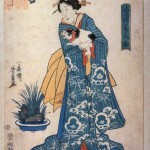
Color – Color pigment was added to the ink to create variation on the scroll. Look for vibrant colors in this woodblock print by Utagawa Yoshikazu from the series Beauty Contest of the Present Day.
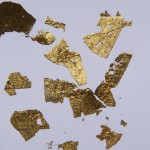
Gold Leaf – This material is very fragile and very thin! Gold leaf is used during the Kirikane process and some of it’s fragile and shimmering qualities are shown in this picture.
Kirikane Process
The kirikane process is a decorative technique used for paintings, sculpture, and lacquer. This process uses gold leaf or silver foil cut into thin strips or small geometric shapes. These metallic shapes are placed in a design and sealed with glue and often laid on lacquer objects. Below are some of the tools that one would use when doing kirikane.
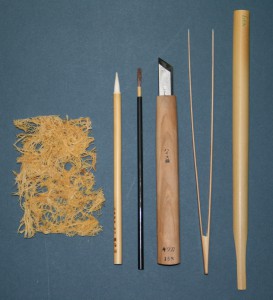
Glossary
Glossary
Bodhisattva – a being that compassionately refrains from entering nirvana in order to save others and is worshipped as a deity in Mahayana Buddhism (Webster).
Kamakura Period – The period from 1185 to 1333 in Japan, during which the basis of feudalism was firmly established. The culture was largely define by the rise of the warrior class.
Monju – Japanese for the Bodhisattva Manjusri; associated with transcendent wisdom.
Samurai – a member of a powerful military caste in feudal Japan, especially a member of the class of military retainers of the daimyos.
Shogun – A “military commander” or “general,” was a hereditary military governor in Japan from 1192 to 1867.
Tea ceremony – In Japanese culture, it is both a spiritual practice and an art form, that brings the host and guests into peaceful communion. The act of preparing and drinking matcha, the powdered green tea uses in the ceremony, is a choreographed art, requiring many years of study and practice.
Zen Buddhism – a Japanese school of Mahayana Buddhism emphasizing the value of meditation and intuition.
Want to see where we’re getting our information?
Want to see where we’re getting our information?
Conservation of Asian Painting Collection Virginia Museum of Fine Arts. Publication. Washington D.C.: Nishio Conservation Studio, 2009. Print., 28 Apr. 2015
Goetz, Philip W. “Bodhisattva.” The New Encyclopedia Britannica. 15th ed. Vol. 2. Chicago: Encyclopedia Britannica, 1990. 31516. Print.
Goetz, Philip W. “Gold Leaf.” The New Encyclopedia Britannica. 15th ed. Vol 5. Chicago: Encyclopedia Britannica, 1990. 33738. Print.
Goetz, Philip W. “Kamakura.” The New Encyclopedia Britannica. 15th ed. Vol 6. Chicago: Encyclopedia Britannica, 1990. 699700. Print.
Goetz, Philip W. “Kamakura Period.” The New Encyclopedia Britannica. 15th ed. Vol 17. Chicago: Encyclopedia Britannica, 1990. 67680. Print.
Goetz, Philip W. “Kirikane.” The New Encyclopedia Britannica. 15th ed. Vol 6. Chicago: Encyclopedia Britannica, 1990. 887. Print.
Goetz, Philip W. “Manjusri.” The New Encyclopedia Britannica. 15th ed. Vol 7. Chicago: Encyclopedia Britannica, 1990. 780. Print.
Goetz, Philip W. “Tea Ceremony.” The New Encyclopedia Britannica. 15th ed. Vol. 11. Chicago: Encyclopedia Britannica, 1990. 59697. Print.
Goetz, Philip W. “The Kamakura Bakufu.” The New Encyclopedia Britannica. 15th ed. Vol 22. Chicago: Encyclopedia Britannica, 1990. 31013. Print.
“Kamakura Period | Japanese History.” Encyclopedia Britannica Online. Encyclopedia Britannica, n.d. Web. 28 Apr. 2015.
Monju (Bodhisattva Manjusri) Crossing the Sea Label at Virginia Museum of Fine Arts, Curator, Plaque 23 Apr. 2015
Unknown Artist. Monju (Bodhisattva Manjursi) Crossing the Sea, Kamakura period (1185-1333) – 14th century. Hanging scroll; ink, color, gold, gold leaf on silk. Virginia Museum of Fine Arts.
Unknown Artist, Monju (Bodhisattva Manjursi) on Lion. 14th century. Wood with polychrome, lacquer, copper, crystal, glass. Virginia Museum of Fine Arts, Richmond, Virginia. Image from Virginia Museum of Fine Arts.
Unknown Artist, Monju Scroll. 14th century. Hanging scroll; ink, color, gold leaf on silk. Virginia Museum of Fine Arts, Richmond, Virginia. Image from the Virginia Museum of Fine Arts.
Explore More:
Monju Scroll: Scroll Through the Past